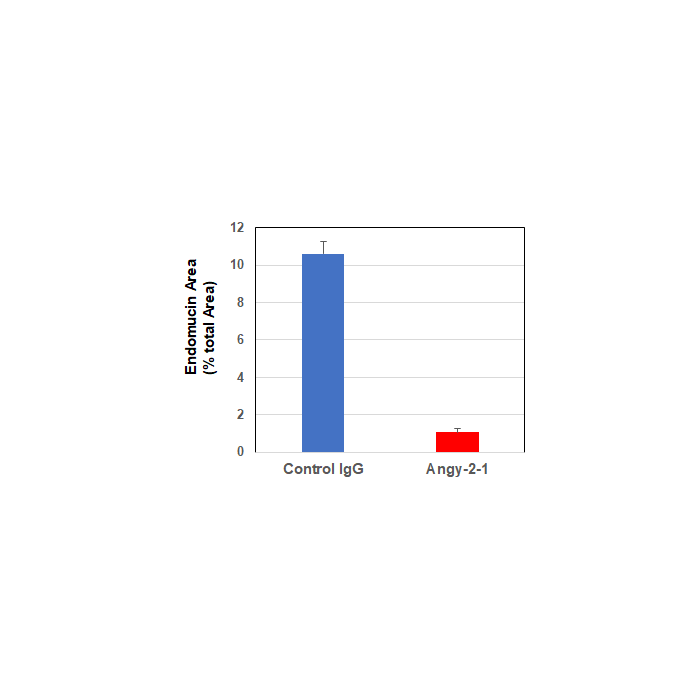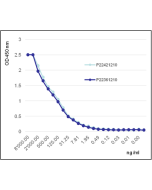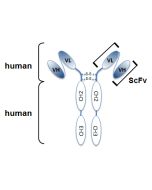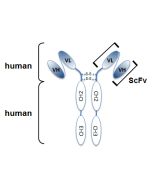Cookie Policy: This site uses cookies to improve your experience. You can find out more about our use of cookies in our Privacy Policy. By continuing to browse this site you agree to our use of cookies.
AdipoGen Life Sciences
anti-Angiopoietin-2, mAb (rec.) (blocking) (Angy-2-1)

Methods: After 5-week antibody injections (4µg/g body weight, twice/week, of anti-Angiopoietin-2, Angy-2-1 (#AG-27B-0016) or an isotype control) along with HFD feeding in C57BL/6 wild-type mice, immunostaining against the blood vessel marker endomucin is performed using an anti-mucin antibody. Statistical result of relative endomucin area in white adipose tissue sections is shown.
Methods: Human umbilical vein endothelial cells (HUVECs) are seeded at a density of 35’000 cells/cm and cultured for 24h. Cells are fixed for 10min with 4% PFA, permeabilized for 5min with 0.1% Triton X-100 in PBS and blocked with 5% donkey serum for 30min. Cells are incubated with the following antibodies for 1h at room temperature; rabbit anti-Willebrand factor (Dako, 1:500), mouse anti-Angiopoietin-2 (Angy-2-1) (1:100). Alexa Fluor 555 and 647 fluorochrome-conjugated secondary antibodies (Invitrogen) are used for signal detection. The cells are imaged using upright confocal microscope Leica SP5 Tandem. Picture courtesy of Dr. Laureline Wetterwald, Tatiana Petrova’s Group, University of Lausanne.
Methods: Tie-2 (h):Fc was coated on an ELISA plate at 1µg/ml. anti-Angiopoietin-2, mAb (rec.) (blocking) (Angy-2-1) (Prod. No. AG-27B-0016) or an unrelated mAb (recombinant) (Control) were added (starting at 40µg/ml with a twofold serial dilution) together with 20ng/µl of Angiopoietin-2 (human) (Prod. No. AG-40B-0114). After incubation for 1h at RT, the binding was detected using an anti-FLAG antibody (HRP).
| Product Details | |
|---|---|
| Synonyms | Ang-2; Ang2; Angpt2; Agpt2 |
| Product Type | Recombinant Antibody |
| Properties | |
| Clone | Angy-2-1 |
| Isotype | Mouse IgG2bλ. |
| Source/Host | Produced without the use of animals. Purified from CHO cell culture supernatant. |
| Immunogen/Antigen | Recombinant human angiopoietin-2. |
| Application |
ELISA |
| Crossreactivity |
Human Mouse |
| Specificity |
Recognizes human and mouse angiopoietin-2. Does not bind human and mouse angiopoietin-1. |
| Purity | ≥95% (SDS-PAGE) |
| Purity Detail | Protein A-affinity purified. |
| Concentration | 1mg/ml |
| Formulation | Liquid. In PBS containing 10% glycerol and 0.02% sodium azide. |
| Isotype Negative Control | |
| Other Product Data |
anti-Angiopoietin-2, mAb (rec.) (blocking) (Angy-2-1) is composed of human variable regions (VH and VL) (λ-chain) of immunoglobulin fused to the mouse lgG2b Fc domain. |
| Shipping and Handling | |
| Shipping | BLUE ICE |
| Short Term Storage | +4°C |
| Long Term Storage | -20°C |
| Handling Advice |
After opening, prepare aliquots and store at -20°C. Avoid freeze/thaw cycles. |
| Use/Stability | Stable for at least 1 year after receipt when stored at -20°C. |
| Documents | |
| MSDS |
 Download PDF Download PDF |
| Product Specification Sheet | |
| Datasheet |
 Download PDF Download PDF |
Angiopoietin-1 (Ang-1) and Angiopoietin-2 (Ang-2) are closely related secreted ligands which bind with similar affinity to Tie-2. Tie-2 and angiopoietins have been shown to play critical roles in embryogenic angiogenesis and in maintaining the integrity of the adult vasculature. Ang-1 activates Tie-2 signaling on endothelial cells to promote chemotaxis, cell survival, cell sprouting, vessel growth and stabilization. Ang-2 has been identified as a secreted protein ligand of Tie-2 and has alternatively been reported to be an antagonist for Ang-1 induced Tie-2 signaling as well as an agonist for Tie-2 signaling, depending on the cell context.
anti-Angiopoietin-2, mAb (rec.) (blocking) (Angy-2-1) is an antibody developed by antibody phage display technology using a human naive antibody gene library. These libraries consist of scFv (single chain fragment variable) composed of VH (variable domain of the human immunoglobulin heavy chain) and VL (variable domain of the human immunoglobulin light chain) connected by a polypeptide linker. The antibody fragments are displayed on the surface of filamentous bacteriophage (M13). This scFv was selected by affinity selection on antigen in a process termed panning. Multiple rounds of panning are performed to enrich for antigen-specific scFv-phage. Monoclonal antibodies are subsequently identified by screening after each round of selection. The selected monoclonal scFv is cloned into an appropriate vector containing a Fc portion of interest and then produced in mammalian cells to generate an IgG like scFv-Fc fusion protein.
- Elevated angiopoietin-2 level in patients with continuous-flow left ventricular assist devices leads to altered angiogenesis and is associated with higher nonsurgical bleeding: C.E. Tabit, et al.; Circulation 134, 141 (2016)
- Angiopoietin 2 induces astrocyte apoptosis via αvβ5-integrin signaling in diabetic retinopathy: J.H. Yun, et al.; Cell Death Dis. 7, e2101 (2016)
- Angiopoietin-2 in white adipose tissue improves metabolic homeostasis through enhanced angiogenesis: Y.A. An, et al.; eLife 6, e24071 (2017)
- Hyperinsulinemia promotes endothelial inflammation via increased expression and release of Angiopoietin-2: S. Chandel, et al.; Atherosclerosis 307, 1 (2020)
- Angiogenesis-associated pathways play critical roles in neonatal sepsis outcomes: M. Fidanza, et al.; Sci. Rep. 14, 11444 (2024)










